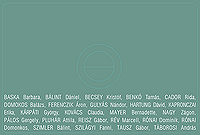|
Mai Manó Gallery ("Kis Manó")

upcoming
exhibition
Visiting the exhibition
IS FREE OF CHARGE!
Momentary Script
Exhibited the works from the University Of Theatre And Film Arts (Budapest) first-year (freshman) cinematography majors (head teachers János Vecsernyés and Tibor Máthé) and fifth-year (senior) directing and cinematography majors Ildikó Enyedi and Tibor Máté.
Opening remarks by: Péter Korniss, photographer
Curator: Gabriella Csizek
Open to the public:
1st July to 14th August 2011
on Weekdays: 14.00 - 19.00
at Weekends 11.00 - 19.00
Exhibited the works from the University Of Theatre And Film Arts (Budapest)
first-year (freshman) cinematography majors (head teachers János Vecsernyés and
Tibor Máthé) and fifth-year (senior) directing and cinematography majors Ildikó
Enyedi and Tibor Máté.
Director of photography for film and television
2006-2011
Head teacher: Tibor Máthé
Barbara Baska
Dániel Bálint
Dávid Hartung
Claudia Kovács
Gergely Pálos
Marcell Rév
Dominik Rónai
Gábor Tausz
2006-2011
Head teacher: Ildikó Enyedi
Áron Ferenczik
Erika Kapronczai
György Kárpáti
Attila Pluhár
Gábor Reisz
Bálint Szimler
2010-
Head teachers: János Vecsernyés and Tibor Máthé
Kristóf Becsey
Tamás Benkó
Rida Cador
Balázs Domokos
Nándor Gulyás
Bernadette Mayer
Zágon Nagy
Domonkos Rónai
Fanni Szilágyi
András Táborosi
“The camera is the most reliable tool for acquiring the skill of objective seeing.”
László Moholy-Nagy
In Hungary, training of film directors and cinematographers began at the College of Theatre and Film with the leadership of Béla Balázs, Géza Radványi, and Gyögy Illés in 1949. Over the course of many decades in teaching cinematography, many have graduated whose movies earned national and international success. High-quality cinematic expression in these movies gave birth to the later deservedly world-famous Hungarian school of cinematography.
Practicing with photographic devices needed for taking still photographs, getting to know the regularities of photographic expression and its visual perception remain important stepping stones in the now university-level curriculum. Since photography, similarly to other forms of visual art, is based on vision, photographic exercises primarily teach students to see. They prepare them how to make the world around them be seen with the help of their camera while, at the same time, capturing any changes in lights and shadows and embracing the joy of recording these moments.
Kosztolányi, the Hungarian author, writes: “Objects are static points of our lives swishing by.” In his spirit, first-year photographic exercises begin with taking pictures of objects close to and made by people under natural, as well as artificial lights. Photographic studies aim at teaching students to visually interpret various forms, materials, surfaces, and light effects; it also encourages students to recognize the inner nature of objects created by humans and to acquire the ability to compose man himself through the language of photography later. An additional goal is to enable students to discover human contents that, so far, have been hidden.
The philosophy of teaching cinematography is parallelity; students have to discover the world around them with their cameras, then later, they have to re-construct the world through their creativity while taking into consideration the particular features of the genre. In the meantime, they also come to realize that there is nothing in our world that would not be worth translating into a visual experience through the language of photography in a two-dimensional space.
Tibor Máthé
The exhibition presents constellations from the world as seen by first- and fifth-year students of the University Of Theatre And Film Arts. Works exhibited show stories condensed into a particular moment that is now recorded as one lifted from time and space.
Each photograph features some or every notion of time. Images exhibited here are open-ended; they leave it up to the observers to decide what they find important considering their own personal stories and to define and complete what they experience.
Artists see different things in different ways – and it’s alright. The viewer, however, can perceive of the individual styles revealed in these differences.
Showcasing the photos in a group, as well, brings about a special, new quality that only lies in this co-existence with the various approaches completing and enriching the various meanings.
Gabriella Csizek
Besides the photos exhibited, there are additional pieces projected.
|
Hungarian House of Photography in Mai Manó House
H-1065 Budapest-Terézváros, Nagymező utca 20.
Telephone: 473-2666
Fax: 473-2662
E-mail: maimano@maimano.hu
|
|
|


